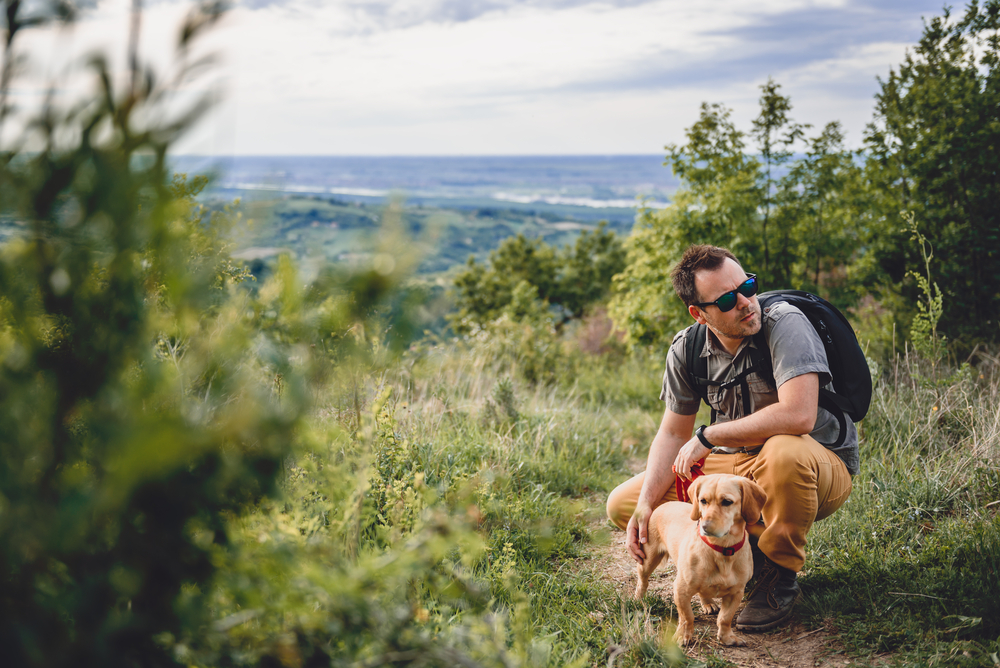If hitting your local hiking trail and camping in the great outdoors sound like your idea of a good time, you’re probably also a dog person. But it may come as a surprise to learn that toy dog breeds love spending time outdoors just as much as their larger cousins. Unfortunately, toy breeds have little legs, and they aren’t built for endurance the same way certain breeds (for example, Labrador retrievers) are. However, that doesn’t mean you need to hire a pet sitter or board your toy breed when you go for a hike. Here’s what you need to know, and a few of our favorite tips for hiking and camping with small dogs.

Can small dogs hike long distances?
If your typical hike covers several miles of trails, you may be wondering if your small dog can keep up with you. Guess what? Experts say that your tiny fur baby can walk as far as 5-10 miles a day, even over rough terrain. (For large breeds, the distance extends to about 10-15 miles.) As a general rule, your puppy can safely walk for five minutes per month of age until he reaches one year. That being said, your dog’s ability to hike long-distance depends on a variety of factors, such as:
- Your dog’s general wellbeing
- Your dog’s experience with hiking
- The climate where you hike (terrain, heat, inclement weather)
We recommend speaking with your veterinarian before taking your dog on a hike. Some breeds, like pugs and French bulldogs, are brachycephalic (the technical term for having a short, wide snout), meaning they’re more likely than other breeds to suffer from heatstroke and breathing difficulties. Additionally, low-slung breeds like dachshunds are prone to back problems and tend to launch themselves off high perches like tiny, four-legged missiles, so they’re not well-suited to long hikes. However, you may still be able to take your pooch hiking with you if you’re willing to carry him along for the ride in a backpack.
How to keep your small dog safe on a hike
Your vet has given your dog the all-clear, and you’re determined to hit the nearest trail. Not so fast. Before you set off on a hike with your pup, you’ll want to learn a few safety guidelines first.

1. Make sure your pup is well-trained
Even if you plan on keeping Fido in a hiking backpack for the bulk of your hike, you’ll still want him to obey your commands. Your pup should know how to follow basic commands, such as “sit” and “come,” before you take him on your next adventure. Just to be on the safe side, we recommend keeping your dog on a leash while he isn’t being carried.
2. Build up your dog’s stamina
Just like you probably didn’t start by hiking Angel’s Landing in Zion National Park, reputed to be one of the most dangerous in the country, your little pup needs time to build up his endurance. Stick to dog-friendly trails (which you can find on Bring Fido), and work your way up from short walks around the neighborhood to your favorite local trail.
3. Be prepared
Whether you plan on heading home at the end of the day or you’ve packed your camping gear, you’ll want to make sure your pooch has everything he needs to stay safe and comfortable. Bring plenty of food and water, any medications you and your dog may need, sun protection, and an extra blanket or two. Remember, even the desert can get cold at night during the summer months. (Also, please be respectful of the environment, not to mention your fellow hikers, and bring poop collection bags with you. Just because your pup is outside does not mean the hiking trail is his new bathroom.)
4. Choose the best time to hit the trails
Hikers and campers know from experience that mountainous trails are much cooler than low-lying areas in summer. Sunny days are especially dangerous for dogs. Once the temperature climbs to 80 degrees or higher, your dog may be in danger of suffering from heatstroke if local humidity levels reach 90 percent. Stick to cooler trails during the summer months, and steer clear of the mountains during the winter to ensure that your pup is comfortable year-round.
5. Bring a kennel for camping trips
If you plan on camping out, you’ll want to make sure your pup doesn’t run off during the night. Unless you’re sleeping in an RV or other vehicle, a dog kennel is essential. Not only will kenneling your dog at night keep him from escaping your tent during bathroom breaks, but it will also keep him safe from curious wildlife.

While taking your dog hiking and camping with you helps solidify your bond (and satisfy your dog’s need to spend time in nature), there are a few steps you’ll want to take before you set out on the trail. Consult your vet before hiking, make sure your pup has everything he needs, and don’t be afraid to cut your trip short if your dog shows signs of exhaustion or agitation. Getting in touch with nature is important, but your dog’s health and happiness mean more.
Editors' Recommendations
- 5 surefire ways to keep your dog off your bed and get a good night’s sleep
- 7 dog training podcasts we’re obsessed with
- 4 effective ways to house-train your stubborn little Chihuahua
- Video: Dog befriends bike thief (or why golden retrievers shouldn’t be guard dogs)
- Video: Adorable dog thinks the TV wants to play fetch




